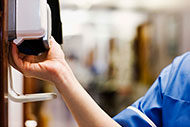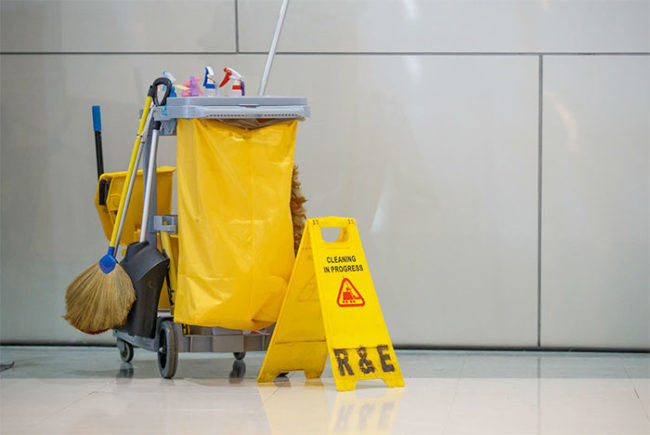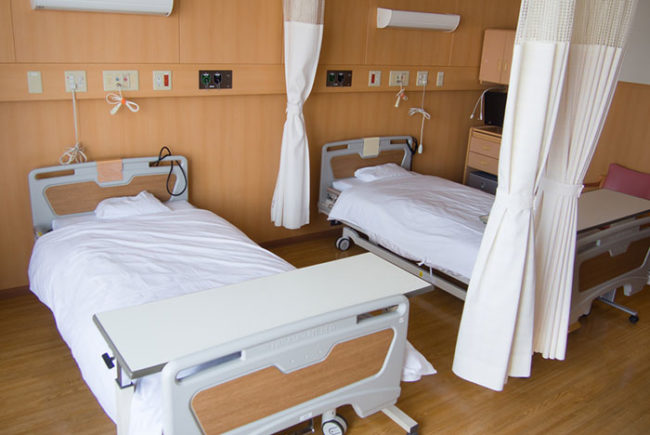Outpatient care continues to accelerate as public policy encourages patients with chronic diseases to get care outside of the hospital setting. According to a 2010 article in the Journal of the American Medical Association, more than three-quarters of all health care operations in the U.S. are performed in settings outside the hospital, including physician offices, hospital-based outpatient clinics and ambulatory surgery centers.
This has created a greater need for effective environmental cleaning programs to reduce the risk of infections for patients. Environmental cleaning is an important component of a complex infection control strategy, but outpatient facilities traditionally have lacked infrastructure and proper resources to execute a detailed infection prevention program, including an effective, standardized environmental cleaning program.
Recent pressure, though, has motivated facilities to change their thinking. In 2015, the Centers for Disease Control and Prevention (CDC) and the Healthcare Infection Control Practices Advisory Committee issued its "Guide to Infection Prevention for Outpatient Settings: Minumum Expectations for Safe Care." It reflects the existing evidence-based guidelines produced by the CDC and the advisory committee and represents expectations for infection prevention and safe care in the ambulatory setting.
Ambulatory challenges
Health systems nationwide are challenged with creating an effective environmental cleaning strategy for their growing numbers of ambulatory facilities. Here are six tips to help outpatient facilities develop an effective environmental cleaning plan:
1. Get all staff involved. All clinical staff should have a stake in implementing the plan. As part of an infection prevention program, the infection preventionist (IP) will help to drive participation and motivate staff. The IP can drive procuring appropriate supplies and products to support best practices, and collaborate with leadership and staff to ensure compliance.
Also in this article |
| Cleaning requirements for acute and ambulatory care |
|
|
Clinical education for anyone who has environmental cleaning responsibilities is a crucial component of an effective environmental services (ES) program. This can include on-site lectures and direct observation of procedures to gauge competency. Online education platforms offer clinical staff the convenience of taking classes 24/7, but this should not be the only form of training provided.
Competency testing that involves direct observation must be performed with ES employees to detect deviation from procedures. This is the most important part of the training process because it allows for immediate feedback and coaching. Just because they have been trained does not mean they can demonstrate competency in performing a particular procedure. Competency training by direct observation should be performed at least annually.
Furthermore, it is important to note that employee turnover plays a role in the training process. The higher the turnover rate, the more often a facility has to introduce new staff to their protocols. It is critical to look at ways to retain staff and provide them with resources to complete their jobs at the highest level. For example, consider implementing an employee recognition program.
2. Focus on specific initiatives. An ES plan that tries to tackle too many initiatives probably will not succeed. With the help of a multidisciplinary team, it is important to perform an annual risk analysis to assess which tactics need improvement. Then each potential initiative should be ranked according to the potential risk that could be incurred by the facility, and the facility team should agree on the top two or three initiatives to be targeted for that year.
3. Establish written policies and procedures. Often there is confusion as to who is responsible for cleaning certain areas or items. Is it an ES or nursing responsibility? There should be clear, written expectations of the cleaning tasks for all staff members. ES professionals should try to develop a chart that highlights pictures of each surface and device and identifies who is responsible for keeping it clean. They should make sure that this tool is located in an area that is accessible to those who perform the tasks and not locked in an office.
You may also like |
| Ambulatory cleaning qualifications |
| ES performance and decentralized care |
| AHE certification takes infection prevention to a higher level |
|
|
There also should be set procedures for cleaning and disinfecting spills of blood, body fluid and other infectious substances. Procedures should be detailed and written in an easy-to-understand language and should consider employees whose first language may not be English. Posters or laminated cards that can be displayed easily can help to keep the policies top of mind for staff.
An ES team’s success in the hospital often is measured by whether they meet an established room turnover time (i.e., 20 minutes). In the outpatient setting, patients quickly move in and out of rooms or areas separated by curtains. In-between patients, cleaning is often a nursing function. With their many other duties that must also be performed, ES staff may miss steps or forget to clean some surfaces. It is critical that facility administrators provide enough time and adequate resources to clean a room properly. For high-volume ambulatory facilities, an ES employee should have this responsibility rather than a nurse.
4. Take an audit of products used. An effective environmental cleaning plan requires high-quality products. There are a variety of different materials used to make cleaning cloths and mops, like cotton and microfiber. ES professionals should make sure that the material of the cloth or mop is compatible with the chemical and the method of cleaning that the facility is utilizing.
Additionally, the chemicals used in disinfectants, detergent/disinfectants and germicidal wipes must be registered by the Environmental Protection Agency with label claims for health care use. The microorganisms that will be killed by the disinfectants, detergent/disinfectants or germicidal wipe should be listed on the side of the container. It is important to know what types of microorganisms a product will and will not kill. There are only a few chemicals that are effective against Clostridium difficile spores, for instance, so facilities should use one product that is registered to kill all microorganisms or two products — one for C. difficile and one for everything else.
The contact or kill time — the amount of time that the surface being cleaned needs to remain wet with the disinfectant for it to effectively kill microorganisms — is another factor that should be used in evaluating cleaning and disinfecting products. ES professionals should look for a product that will kill the largest number of microorganisms in the shortest period of time. Staff members should be educated and trained on the use of each product, especially kill times.
As always, the manufacturer's instructions for use must be followed. Failure to do so could result in inadequate cleaning and disinfection of surfaces and devices.
Additionally, automated no-touch decontamination technologies are gaining acceptance for enhancing ES programs as there is growing evidence that these devices can improve terminal cleaning. Some of the methods include aerosol and vaporized hydrogen peroxide, mobile devices that emit continuous ultraviolet UV-C (germicidal) light, and xenon pulse UV systems. However, they are often costly and take a certain amount of time to complete the job.
5. Efforts should be monitored. An ES program should include at least two monitoring methods. Utilizing patient satisfaction surveys to monitor the cleanliness of a patient room can provide feedback. However, it is important to note that just because a room looks and smells clean does not mean it has been properly disinfected. Swab cultures and agar slide cultures are additional methods that can be used, but they are not really feasible in an ambulatory setting or in most hospital settings.
Here are a few other things to consider that are more user-friendly and require fewer resources:
- Observing the cleaning process as it is being performed provides an opportunity to evaluate adherence to the procedure and the ability to provide real-time feedback. Observing a room after it has been cleaned only will identify the areas that appear to be clean.
- Fluorescent gel is the most popular marker, although there are other types (powder and lotion), but they have limitations that make them difficult to execute. Fluorescent gel is applied to high-touch surfaces before the area is cleaned, dries transparent on surfaces and resists abrasion. This makes it difficult for ES workers to see where it was placed. Studies have shown that this is a good way to evaluate cleaning practices objectively and quantify the impact of educational interventions on the cleaning practice.
- Adenosine triphosphate (ATP) bioluminescence testing is the measurement of organic ATP on surfaces using a luciferase assay and luminometer. This method has been used in the food industry for more than 30 years to evaluate the cleanliness of food preparation areas.
ATP testing is simple and can be used to quickly access the efficacy of a facility’s cleaning methods. A special swab is used to sample a specific cleaned surface (i.e., countertop, keyboard, floor, surgical table). The swab is then inserted into a handheld portable meter. The total amount of ATP, both microbial and nonmicrobial, is quantified and expressed as relative light units.
Readout scales and sensitivities can vary between different ATP systems, but very low readings typically are associated with low aerobic colony counts. Very high readings may represent either a viable bioburden, organic debris, including dead bacteria, or a combination of both.
To determine if a surface has been cleaned to an acceptable level, ES professionals will need to set a cutoff level. Below the cutoff indicates that the surface has been cleaned appropriately. If it is above the cutoff level, the surface is still considered to be dirty and in need of further attention. The manufacturer’s recommendations should be used to establish the cutoff level.
6. Ask the right questions when outsourcing services. Some facilities may consider outsourcing their ES services to a commercial cleaning service. If this is the case, they should take an in-depth look at current operations and determine cleaning priorities before contracting with a service. The budget should, of course, be taken into consideration. The most effective companies could provide some benefits that cannot be achieved with an in-house program, including focused experience with medical and health care cleaning accounts, a regular inspection process to ensure quality and consistency, Cleaning Industry Management Standard certification with adherence to bloodborne pathogen guidelines and knowledge of HIPAA regulations.
Create a plan
While outpatient facilities vary greatly in the number of resources dedicated to infection prevention and environmental cleaning, it is crucial for facilities to create a tangible plan.
With everyone’s participation and commitment to enhancing disinfection practices, a strong culture will be developed that ultimately leads to a safe environment and better patient outcomes.
Barbara Connell is vice president of clinical services at Medline Industries Inc., Northfield, Ill. She can be reached at bconnell@medline.com.






